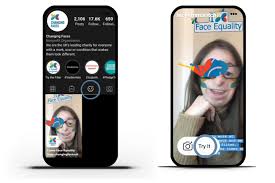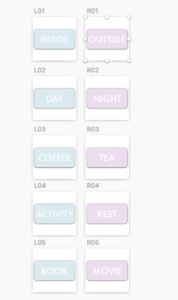PREMISE
WITH THE USE OF AUGMENTED REALITY, I STUDIED WHETHER AN INSTAGRAM AR FILTER CAN NUDGE PEOPLE TOWARDS TAKING FEW MINUTES A DAY TO PRACTICE SELF-LOVE.
SYNOPSIS
Self-love is “an active practice of accepting, caring for and encouraging oneself” (Ali, 2019). For the past few years, lifestyle influencers and news sites have heavily promoted it on social media. It has been recognized as a necessary characteristic for survival (Makujina, 1997). In the same time, the need of self-love (or self-compassion) has been increasingly highlighted as an important element of well-being.
Online interventions have been found useful and accessible for those who want to develop a (greater) sense of self-love (Nadeau et al, 2020). One of the techniques used for improving the sense of self-love is the use of recommendation systems. They provide space for the user to determine their preferences and therefore increases the chances of the successful online intervention. To make the topic of self-love more visible and the interventions more accessible, there is a need of innovative solutions.
RESEARCH
Self-love (also understood as self-compassion) within the academic literature is linked with different phenomena and researched from different perspectives. Self-love is an unconditional acceptance of oneself, and self-compassion relies on embracing the feelings of kindness towards oneself (Braehler & Neff, 2020). Other studies describe it as healthy (Gilbert, 2009) and generating feelings of safety and is perceived to be an antidote for shame. Research shows that it is linked to our well-being (Nadeau et al., 2020).
In recent years, various research has been done on self-compassion and online interventions. Research done in the scope behaviour intervention and personalization practices found that a big potential to support and encourage people during their behaviour change process (Masthoff et al., 2014). Personalization of the intervention seems to be a key factor for its effectiveness. The research shows that the effectiveness of the techniques used for behaviour change, whether it is persuasion or motivational strategy. Evidence shows that it has a potential for it to be learnt using smartphone applications (Linadron, 2019). The benefits of such interventions are the elimination of accessibility issues. Another benefit is the possibility of using it on the wider scale which allows to reach wider audience.
One of the tools used in digital behaviour interventions are Persuasive Technologies. They focus on providing users with interactive solution that can influence them. One of such tools used in practice are recommender systems. In literature, recommender systems are described as an assistance tool that will fall into the scope of their preferences (Najafabadi & Mahrin, 2016). They are perceived as software techniques that provide output in the form of suggestions. Augmented Reality is another persuasive technology that has potential to influence people through delivering enriched content through adding another layer to an already-existing environment (Smink et al., 2020). AR applications create opportunities for immersion, stimulation and interaction (Rutledge, 2021). The use of AR allows the users to engage and feel more connected and keeps their attention for longer. Thus, the combination of the two Persuasive Technologies should result in highly engaging and stimulating tools.
INSPIRATION


PROTOTYPES & ITERATIONS
The AR technology on Instagram (and Snapchat) is predominantely used by millennials and gen Z. It is due to the fact that those are the biggest user groups of those platforms. Those are the first generations raised in the constant presence of mobile technologies. They are more likely to be interested in participating in challenges and sharing those with their friends. What is also interesting is that there is a lack of easily accessible persuasive technologies in the sphere of self-love and self-compassion, which would show the importance of taking care of oneself and nudge users towards making small changes. The filters are often used as sort of “predictions” like “In 2020” filter which was showing the user the random card with something that will happen to them that year. They are accessible and easy to use which makes them extremely popular.
The solution consists out of ready-to-use AR filter which will be an impulse for the users to think about their own well-being and what they like to do to take care of themselves. They will be able to get a recommendation of an activity to do that day or multiple activities if they wish. It’s an easy to use, free and accessible tool to raise the awareness of importance of self-love amongst younger generations.
FIRST ITERATION
The first prototype was made through trial and error with Spark AR. The ideas for the activities included within the prototype were taken out of self-help books like “Buy yourself the lilies” and through asking fellow students what they do to practice self-love. After creating 10 cards, I got feedback from potential users, which resulted in adding more activities into the filter. The cards for the filter were created with the use of Sketch. The goal for this iteration was to find out whether the potential users would be interested in such solution and whether they feel convinced to take action towards practising self-love.


After creating a working prototype of the filter, I sent it through the link for 10 potential users from the target group to gather their feedback. The users suggested to add frames into all the cards, and change the font to something a bit more “sophisticated”.
The participants of user testing said the intention behind it is clear and that they would definitely use it. They also found it to be an interesting option to have in handy if they want to try out new things or remind themselves what gives them joy and feels like putting effort in taking care of themselves. However, it was also highlighted that for this solution to be successful, the UI of the filter has to be re-designed in order to be more visible, readable and visually appealing.
Link to video with prototype 1
Second iteration
The idea behind the second iteration was to provide the users with a prototype that was adjusted accordingly to their feedback and give them a better experience of using the filter. The colours, font and framing of the cards were re-adjusted and the updated version was re-uploaded. The filter was also verified by Meta team which means that now it can be used amongst the users on Instagram. This made user testing easier as any user with a link can try it out instead of adding users manually into the file on Spark AR.
The second testing was carried out with 10 potential users who used the filter to get a random recommendation of self-love activity to do that day. The users liked the new looks of the filter more than the version from the first prototype and were enthusiastic about using it. In opinion of the participants of the test, the filter gave them a push towards thinking about themselves when they go through social media and putting effort into self-care. What became clear in the second iteration is that the users would like to have more personalised propositions of the activities. This finding was also backed up by literature on the topic. Those suggestions were a base for the third iteration of the prototype.

Link to video with prototype 2
Third iteration
In the third iteration, my priority was to improve the prototype in terms of personalization: it was pointed out in earlier stages that the users for example got a recommendation of going to their favourite coffee place but that particular user didn’t drink coffee. This iteration intended to combine AR and recommendation systems as the online intervention for the users.
For this purpose, a new filter was created. It allows users to choose 5 of their preferences out of 10 preference options (so called “this or that” filter). At the end, the user gets the recommendation for an activity based on their answers. This iteration required creating new cards to chose from by users in Sketch and creating a new the flow in patch editor in Spark AR.

This version of prototype was tested by five participants. This test showed that some of the users were unaware that they wish to have more personalization before it was given to them. All five participants agreed that they would share this filter with their friends and challenge them to show themselves some self-love.

Link to video with prototype 3
Final prototype
As shown above, the prototype now allows the users to chose between two different otpions that lead towards the final result. For now the prototype shows the same outcome for everyone, however, what was found the most important by the users was the intent of personalizing their recommendation rather than actually receiving the recommendation from prototype.
Conclusion
Self-love is an important factor influencing our well-being of people and therefore should be more highlighted within social media. For the participants of the user testing, the AR filter developed for this research is a good starting point to do small things for themselves. An added value of this tool is that it allows to share it easily amongst friends, challenging each other and sharing their experiences with the self-love activities recommended through the filter. In the first three iterations, the users have found the augmented reality filter to be an interesting tool to start practicing self-love. The future research in this scope should start with improving the final version of the prototype so that it actually can give recommendations of activities based on user’s choices. In the graduation project I plan to follow this topic. I will focus on creating an application that would recommend activities for the users based on their preferences and hobbies.
References:
Ali, S. (2019). The self love workbook: A life-changing guide to boost self-esteem, recognize your worth and find genuine happiness. Ulysses Press.
Braehler, C., & Neff, K. (2020, February 7). Self-compassion in PTSD. Emotion in Post-traumatic Stress Disorder. Retrieved June 12, 2022, from https://www.sciencedirect.com/science/article/pii/B978012816022000020X
Gilbert, P. (2009). Compassion: Conceptualisations, research and use in psychotherapy.Routledge.
Linardon, J. (2019, November 26). Can acceptance, mindfulness, and self-compassion be learned by smartphone apps? A systematic and meta-analytic review of Randomized Controlled Trials. Behavior Therapy. Retrieved June 11, 2022, from https://www.sciencedirect.com/science/article/pii/S0005789419301236
Makujina, J. (1997). The second greatest commandment and self-esteem. Retrieved June 12, 2022, from https://tms.edu/wp-content/uploads/2021/09/tmsj8j.pdf
Masthoff, J., Grasso, F., & Ham, J. (2014, September 5). Preface to the special issue on personalization and behavior change – user modeling and user-adapted interaction. SpringerLink. Retrieved June 12, 2022, from https://link.springer.com/article/10.1007/s11257-014-9151-1
Nadeau, M. M., Rochlen, A. B., & Caporale-Berkowitz, A. (2020, December 10). Improving women’s self‐compassion through an … – wiley online library. Journal of Counseling and Development. Retrieved June 12, 2022, from https://onlinelibrary.wiley.com/doi/full/10.1002/jcad.12353
Najafabadi, & Mahrin. (2016). A systematic literature review on the state of research and practice of … Retrieved June 11, 2022, from https://www.researchgate.net/publication/283161260_A_systematic_literature_review_on_the_state_of_research_and_practice_of_collaborative_filtering_technique_and_implicit_feedback
Rutledge, P. (2021, May 25). The persuasive impact of augmented reality. DR. PAM RUTLEDGE | MEDIA PSYCHOLOGY. Retrieved June 13, 2022, from https://www.pamelarutledge.com/resources/articles/the-persuasive-impact-of-augmented-reality/
Smink, A. R., Reijmersdal, E. A. van, Noort, G. van, & Neijens, P. C. (2020, July 24). Shopping in augmented reality: The effects of spatial presence, personalization and intrusiveness on app and Brand responses. Journal of Business Research. Retrieved June 13, 2022, from https://www.sciencedirect.com/science/article/pii/S0148296320304586